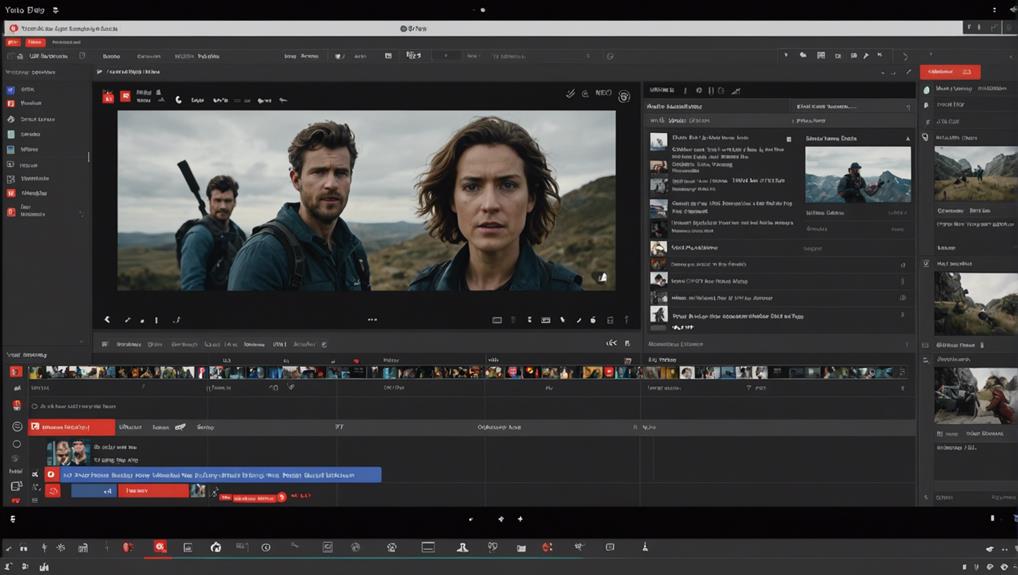To write an engaging script for your YouTube videos, start by defining your target audience and what they care about. Grab attention with a compelling hook in the first 15 seconds. Outline your content clearly: introduction, main points, and a strong call to action. Use relatable storytelling with characters and conflicts. Write in a conversational style, using short sentences and active voice. Edit rigorously to eliminate fluff and guarantee clarity. Always address viewer pain points and offer solutions. Ready to captivate your audience and boost engagement? There's even more to explore on this journey!
Key Takeaways
- Identify your target audience and tailor the script to address their specific interests and pain points.
- Start with a compelling hook within the first 10-15 seconds to capture viewer attention.
- Structure the script with a clear introduction, engaging main content, and a strong call to action.
- Use storytelling techniques with relatable characters and plotlines to maintain viewer engagement.
- Write in a conversational style with short sentences and active voice to enhance readability and connection.
Define Your Target Audience
To write a script that truly resonates, you first need to define your target audience. Start with audience analysis — delve into their demographics, interests, and behaviors. This isn't just about knowing their age or location; it's about understanding what makes them tick.
Create detailed viewer personas that encapsulate your audience's characteristics and preferences. These personas will be your guiding light, helping you craft scripts that speak directly to your viewers.
Once you've got a clear picture of who your audience is, move on to targeted messaging. Your content needs to address their specific pain points and needs. Are they looking for quick tips, in-depth tutorials, or maybe just a bit of entertainment? Tailor your script to fit those desires.
Content relevance is essential here; if your script doesn't align with what your audience wants, you'll lose them.
Use language that resonates with your audience, making them feel understood and valued. This connection fosters loyalty and keeps viewers coming back.
Craft a Compelling Hook
Grabbing your viewer's attention right from the start is essential to keep them hooked throughout your video. A compelling hook is key to achieving this, as it reassures viewers that your content will address their needs and interests. The first 10-15 seconds are vital; you need to pack a punch with your opening to maximize hook effectiveness and positively impact audience response.
Begin by clearly conveying your video's value proposition. Let your viewers know exactly what they'll gain by sticking around. Whether it's a shocking statistic, a burning question, or a teaser of what's to come, your hook should be specific, clear, and engaging.
To further enhance hook effectiveness, make sure it aligns with the interests of your target audience. Tailoring your hook to resonate with their concerns and curiosities increases the likelihood of viewer engagement and retention.
Analyzing viewer engagement and retention metrics can help you refine your hooks over time. Pay attention to where viewers drop off and adjust your opening strategies accordingly. By continually improving your hooks, you keep your audience engaged and coming back for more, setting the stage for a successful video script.
Develop a Structured Outline
Crafting a structured outline for your YouTube video isn't just a good idea—it's essential for keeping your content focused and engaging. A well-organized script structure helps you maintain viewer interest from start to finish. Think of your outline as a visual storyboard; it guarantees your video flows logically and covers all key points effectively.
Start with an attention-grabbing introduction, then move into your main content, and don't forget those smooth connections. Finally, wrap things up with a compelling call to action. This structure not only enhances the viewer experience but also saves you time during video creation and editing.
Here's a simple table to guide you:
| Section | Purpose |
|---|---|
| Introduction | Hook the audience |
| Main Content | Deliver key information |
| Connections | Maintain flow and coherence |
| Call to Action | Engage viewers post-content |
| Visual Storyboard | Map visuals to your script |
Developing a structured outline acts as a roadmap for your video, ensuring you hit all the important points without straying off-topic. This method keeps your content clear, concise, and highly engaging, making it easier for viewers to follow along and stay interested.
Incorporate Storytelling Elements
To captivate your audience, weave in storytelling elements like relatable characters and compelling plotlines. Use emotional triggers to forge a deep connection, keeping viewers hooked from start to finish.
Craft your narrative with care, and watch your content become more memorable and impactful.
Craft Relatable Characters
When you weave relatable characters into your YouTube script, you tap into the emotional core of your audience, making your content irresistibly engaging. By focusing on character dynamics and emotional connections, you create a narrative that resonates deeply with viewers.
Relatable characters possess distinct personality traits, clear motivations, and face genuine challenges. This authenticity draws viewers in and keeps them invested in your story. Think about how each character interacts with others and how these interactions evolve. This dynamic not only adds depth but also sets the stage for emotional connections.
Here's a quick breakdown of how to craft these characters:
| Character Aspect | Description | Impact on Audience |
|---|---|---|
| Personality Traits | Unique, identifiable characteristics | Makes characters memorable |
| Motivations | Clear goals or desires | Helps viewers understand actions |
| Challenges | Obstacles or conflicts | Creates tension and engagement |
| Character Arcs | Growth or transformation | Provides satisfaction and closure |
Develop Compelling Plotlines
By weaving storytelling elements like character development, conflict, and resolution into your script, you'll create plotlines that captivate and engage your audience from start to finish. Start with character dynamics that viewers can relate to. This means showing how your characters interact, grow, and change over time.
Create moments of conflict that challenge them and drive the story forward. Without conflict, there's no story—so make sure it's compelling!
Incorporate unexpected twists to keep your audience on their toes. A surprise plot twist can reignite interest and keep viewers glued to the screen. These twists should feel natural and enhance the story, not just shock for the sake of it.
Emotional connections are key. Your audience should feel invested in your characters and their journey. Use relatable situations and emotional appeal to deepen those connections.
Craft a clear beginning, middle, and end to your narrative so your viewers always know where the story is headed, even if the twists surprise them.
Lastly, focus on conflict resolution. Give your audience a satisfying conclusion that ties up loose ends and reinforces the journey they've been on. This will make your YouTube video scripts not only engaging but also memorable.
Use Emotional Triggers
Tapping into your audience's emotions through relatable stories and personal anecdotes can transform your script from good to unforgettable. By weaving emotional triggers into your content, you create a powerful viewer connection that resonates on a deeper level.
Use storytelling elements like conflict, resolution, and emotional arcs to engage and captivate your audience. When viewers see their own struggles and triumphs reflected in your stories, the emotional impact of your message is amplified.
Incorporating specific emotions such as joy, sadness, excitement, or nostalgia can evoke strong reactions. Share a personal story that mirrors a common experience or challenge your audience faces; this not only humanizes you but also makes your content more relatable and memorable.
Imagine the emotional impact when you recount a heartfelt moment of overcoming adversity or achieving a significant milestone. Such narratives can foster empathy, boost engagement, and enhance content retention.
Crafting compelling narratives with emotional hooks can lead to higher viewer interaction, more shares, and ultimately, channel growth. So, don't shy away from tapping into emotions—embrace them. Your viewers won't only appreciate the authenticity but also feel more connected to your content.
Address Pain Points
Addressing your viewers' pain points is essential for crafting engaging scripts. Identify their challenges and offer practical solutions to show you understand their struggles.
This approach not only boosts engagement but also builds trust and loyalty.
Identify Viewer Challenges
To truly engage your audience, start by pinpointing their biggest challenges and pain points. Knowing exactly what your viewers struggle with is essential for crafting a compelling content strategy that boosts audience engagement. Delve into viewer feedback through comments and social media interactions to uncover common issues. Surveys can also provide valuable insights into what your audience wants to see.
Analyze trends in your niche using tools like Google Analytics to track viewer behavior and preferences. Conduct keyword research to find topics that resonate with your audience's needs. This approach guarantees your content delivery hits the mark every time.
Here's a quick breakdown to help you identify viewer challenges effectively:
| Method | Tool | Benefit |
|---|---|---|
| Analyzing Comments | YouTube Comments | Direct viewer feedback |
| Surveys | Google Forms | Specific insights on challenges |
| Social Media | Twitter, Instagram | Trends and real-time interactions |
| Keyword Research | Google Keyword Planner | Discover high-interest topics |
Offer Practical Solutions
Offering practical solutions to your viewers' pain points transforms your content from merely informative to genuinely impactful. To do this effectively, you need to identify the common issues your target audience faces and tailor your content to address these challenges directly.
This approach not only boosts audience engagement but also establishes you as a valuable resource in your niche.
Start by researching and pinpointing the specific problems your audience encounters. Use surveys, comments, and social media interactions to gather data. Once you've identified these pain points, craft your script to present actionable solutions.
Don't just tell your audience what to do—show them how. Use clear examples, data, and even statistics to support your advice, making your solutions more credible and easier to follow.
Incorporating real-world examples and success stories can make your content relatable and practical. This method not only keeps your viewers engaged but also increases their retention of the information you provide.
Prioritize clarity and simplicity in your video production. By addressing pain points with practical, well-supported solutions, you'll create a loyal following and significantly enhance your video production's effectiveness.
Write in a Conversational Style
Imagine you're chatting with a friend over coffee—this is the vibe you want to capture in your YouTube script. Using casual language and creating engaging content help your viewers feel like they're part of a friendly conversation, not just an audience. This relatable tone and friendly approach make your videos more enjoyable and accessible. Think about how you'd explain something to a buddy. You wouldn't use jargon or overly formal language; instead, you'd keep it simple and fun.
Humor can be your secret weapon here. A well-placed joke or a light-hearted comment can break the ice and keep your viewers hooked. Remember, you're not delivering a lecture; you're sharing something cool with friends. This makes complex topics less intimidating and more digestible.
Your goal is to connect on a personal level, so imagine your viewer sitting right across from you. Ask questions, share anecdotes, and invite them into your world. This conversational style not only makes the content more relatable but also builds a stronger bond with your audience. By being approachable and genuine, you'll keep them coming back for more.
Use Short Sentences and Active Voice
You'd be amazed at how short sentences and active voice can make your script pop. When you use short sentences, you improve readability and comprehension, which are key for audience engagement. Viewers can easily follow along, and they're more likely to stay interested.
Active voice adds energy and directness, making your script feel dynamic and immersive. It's like you're speaking directly to your viewers, creating a sense of immediacy and involvement.
Imagine you're crafting a script about visual storytelling. Instead of saying, 'The story is told through images,' say, 'Images tell the story.' The second sentence is shorter and uses active voice, making it more engaging. Your viewers will feel the difference.
Clarity and impact are essential in YouTube scripts. Short sentences keep your message clear and easy to grasp. Active voice keeps it compelling and lively. This approach enhances your conversational tone, drawing viewers in and making them feel connected.
Edit and Refine Your Script
After drafting your script, it's crucial to edit and refine it to guarantee maximum engagement and clarity. The editing process is where your script truly comes to life, ensuring it captivates your audience and enhances your delivery.
Here's how you can polish your script effectively:
- Eliminate Unnecessary Information: Cut out any fluff or redundant details that don't add value. This keeps your content concise and maintains audience interest throughout.
- Read Aloud for Pacing: Read your script out loud to catch awkward phrasing and ensure a smooth flow. Adjustments here will improve engagement by making your delivery more natural and dynamic.
- Utilize Editing Tools: Use tools like Wordtune to refine sentence structure, eliminate repetition, and polish your script's overall quality. This enhances clarity and ensures your message is sharp and engaging.
- Seek Feedback: Get input from others to identify areas for improvement. Fresh perspectives can highlight issues you might've missed, helping you refine your script for maximum impact.
Include a Strong Call to Action
A compelling call to action (CTA) in your YouTube video script can transform passive viewers into active participants. Engaging viewers with a strong CTA isn't just a nice-to-have; it's a necessity. By clearly prompting viewers to like, comment, subscribe, or visit your website, you maximize engagement and drive desired actions.
Research shows that videos with a well-crafted call to action tend to have higher conversion rates and viewer interaction. A powerful CTA guides your audience on what steps to take next, keeping them hooked and coming back for more. This not only boosts your video performance metrics but also contributes to increased audience retention and channel growth.
Think about what you want your viewers to do. Whether it's hitting that subscribe button, leaving a comment, or sharing your video, be explicit. Phrases like "Subscribe for more tips" or "Comment below with your thoughts" can be incredibly effective.
Implementing an effective call to action strategy can help you achieve specific goals and objectives for your YouTube channel, turning casual viewers into loyal fans. So, don't shy away from directing your audience—make your CTAs clear, compelling, and concise.
Frequently Asked Questions
How to Write an Engaging Youtube Script?
Begin with an engaging hook to grab attention. Use humor and a conversational tone to boost audience engagement. Address their pain points with valuable solutions. Include clear calls to action and use visual cues to keep them interested.
Do Youtubers Write Scripts for Their Videos?
Yes, most YouTubers write scripts. Script benefits include improved content structure and engagement. Use planning tips like setting clear objectives, incorporating humor, and maintaining a conversational tone to keep viewers hooked and boost your channel's growth.
Do You Need a Script to Make a Youtube Video?
You don't need a script to make a YouTube video, but it helps. Script pros include clear communication and better organization, while improvisation benefits offer spontaneity and authenticity. Balance both for engaging, high-quality content.
How Long Should a Youtube Script Be?
For a 10-minute video, aim for a script length of 500 to 1,500 words. For shorter videos, like 5 minutes, 300 to 900 words work best. Tailor your script to the video duration for best engagement.
Conclusion
Now you've got the tools to write an engaging script for your YouTube videos. By knowing your audience, crafting a hook, using storytelling, and keeping it conversational, you'll captivate viewers from start to finish.
Remember, short sentences and active voice make your content punchier. Refine and edit until it's perfect, then wrap up with a strong call to action.
Follow these steps, and you'll create videos that not only attract but also retain and grow your audience.
Happy scripting!




